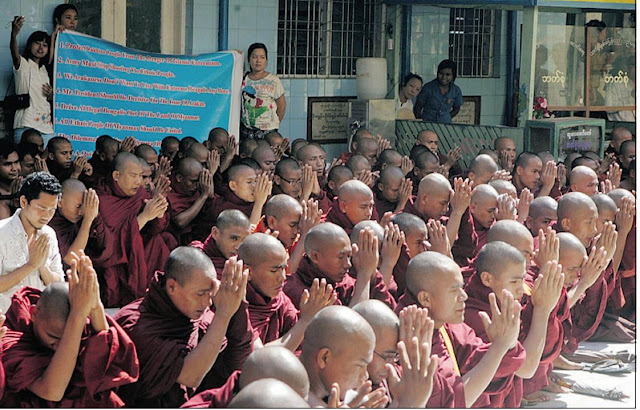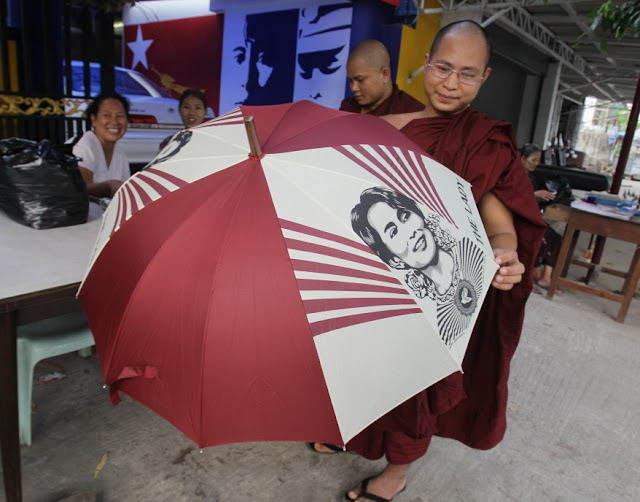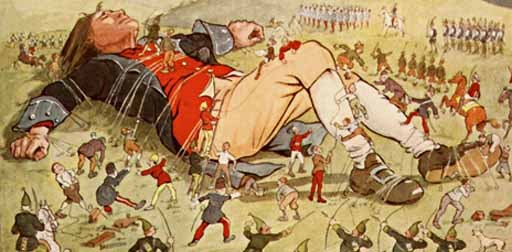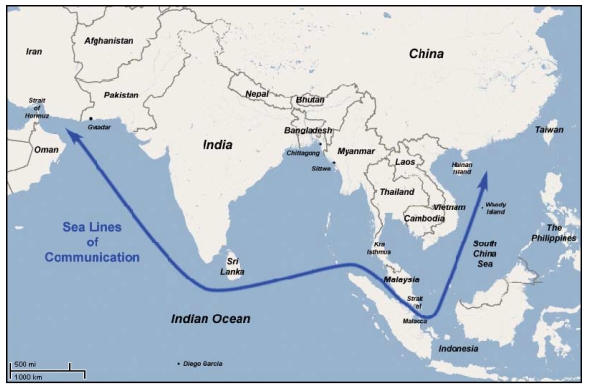Supporters of Aung San Suu Kyi, leaders of the “Saffron Revolution,” leading ethnic cleansing of Myanmar refugees.
People don’t just come out into the streets and begin murdering each other. There are always instigators on one side, perhaps both, leading the anger and violence. In the case of targeted Muslim Rohingya refugees in Myanmar’s Rakhine state, those leading the the violence against them, which most recently involved 26 killed and 2,000 Rohingya homes destroyed, have been identified.
While the Associated Press (AP) features grainy photos of monks outside the city hall in Yangon, Myanmar, claiming that it is a rally “against violence,” the signs themselves tell a different tale. One enumerates, in English, the demands of the “monks.” The sign includes:
1. Protect Rakhine People from the Dangers of Islamic Extremism.
2. Army Must stop Shooting the Ethnic People.
3. We Arakanese Don’t Want to Live With Extreme Bengalis Anymore.
4. Mr. President Should be Decisive on the Issue of Arakan.
5. Drive all illegal Bengalis out of the Land of Myanmar.
6. All Ethnic People of Myanmar Should be United.
The sign continues, but is obstructed in all the shots provided by AP. All of the news stories featuring the picture do not mention any of the enumerated points on the sign, and instead claim, “Myanmar Buddhist monks offer prayers Thursday during a rally of more than 100 people protesting recent violence.”
By “Army Must stop Shooting the Ethnic People,” the protesters mean the army should stop firing on their vigilantes for attempting to eradicate the refugees, as the points on the sign enumerate clearly they are the united ethnic people of Myanmar, and the refugees are “illegal Bengalis.”
Image: Praying for genocide. While Associated Press claims these protesters are demonstrating against ethnic violence, the sign they carry clearly states that they seek the expulsion of the refugees from Myanmar, and are merely protesting against the Myanmar Army’s use of force to protect them from attacks that have left scores dead and thousands of refugee homes destroyed.
In the summer and early fall of 2012 when this wave of violence had again erupted, AFP reported in their article, “Monks stage anti-Rohingya march in Myanmar,” that the marching “monks” supported President Thein Sein’s plan to expel the Rohingya, before paradoxically admitting that Thein Sein has accused the marchers of “kindling hatred toward the Rohingya.”
AFP, in a grave lapse of professional journalism, refers to the leader of this movement as merely “a monk named Wirathu.”
However, this isn’t merely “a monk named Wirathu,” but “Sayadaw” (venerable teacher) Wirathu who has led many of “democratic champion” Aung San Suu Kyi’s political street campaigns and is often referred to by the Western media as an “activist monk.”
In March of this year, Wirathu had led a rally calling for the release of so-called “political prisoners,” so designated by US State Department funded faux-NGOs. Wirathu himself was in prison,according to AFP, for inciting hatred against Muslims, until recently released as part of an amnesty, an amnesty US State Department-funded (page 15, .pdf) Democratic Voice of Burma claims concerned only “political prisoners.”
Human Rights Watch itself, in its attempt to memorialize the struggle of “Buddhism and activism in Burma” (.pdf), admits that Wirathu was arrested in 2003 and sentenced to 25 years in prison along with other “monks” for their role in violent clashes between “Buddhists and Muslims” (page 67, .pdf). This would make Wirathu and his companions violent criminals, not “political prisoners.”
While Western news agencies have attempted to spin the recent violence as a new phenomenon implicating Aung San Suu Kyi’s political foot soldiers as genocidal bigots, in reality, the sectarian nature of her support base has been back page news for years. AFP’s recent but uncharacteristically honest portrayal of Wirathu, with an attempt to conceal his identity and role in Aung San Suu Kyi’s “Saffron” political machine, illustrates the quandary now faced by Western propagandists as the violence flares up again, this time in front of a better informed public.
During 2007’s “Saffron Revolution,” these same so-called “monks” took to the streets in a series of bloody anti-government protests, in support of Aung San Suu Kyi and her Western-contrived political movement. HRW would specifically enumerate support provided to Aung San Suu Kyi’s movement by these organizations, including the Young Monks Union (Association), now leading violence and calls for ethnic cleansing across Myanmar.
The UK Independent in their article, “Burma’s monks call for Muslim community to be shunned,” mentions the Young Monks Association by name as involved in distributing flyers recently, demanding people not to associate with ethnic Rohingya, and attempting to block humanitarian aid from reaching Rohingya camps.
The Independent also notes calls for ethnic cleansing made by leaders of the 88 Generation Students group (BBC profile here) – who also played a pivotal role in the pro-Suu Kyi 2007 protests.
“Ashin” Htawara, another “monk activist” who considers Aung San Suu Kyi, his “special leader” and greeted her with flowers for her Oslo Noble Peace Prize address earlier this year, stated at an event in London that the Rohingya should be sent “back to their native land.”
The equivalent of Ku Klux Klan racists demanding that America’s black population be shipped back to Africa, the US State Department’s “pro-democratic” protesters in Myanmar have been revealed as habitual, violent bigots with genocidal tendencies and enumerated designs.
Their recent violence also casts doubts on Western narratives portraying the 2007 “Saffron Revolution’s” death toll as exclusively the work of government security operations.
Like their US-funded (and armed) counterparts in Syria, many fighting openly under the flag of sectarian extremism held aloft by international terrorist organization Al Qaeda, we see the absolute moral bankruptcy of Myanmar’s “pro-democracy” movement that has, up until now, been skillfully covered up by endless torrents of Western propaganda – Aung San Suu Kyi’s Nobel Peace Prize and a recent showering of Western bestowed awards, all being part of the illusion.
Sectarian Violence, Destabilization: What’s in it for the West?
In “Myanmar (Burma) “Pro-Democracy” Movement a Creation of Wall Street & London,” it was documented that Suu Kyi and organizations supporting her, including local propaganda fronts like the New Era Journal, the Irrawaddy, and the Democratic Voice of Burma (DVB) radio, have received millions of dollars a year from the Neo-Conservative chaired National Endowment for Democracy,convicted criminal and Wall Street speculator George Soros’ Open Society Institute, and the US State Department itself, citing Britain’s own “Burma Campaign UK (.pdf).”

Image: The Myitsone Dam, on its way to being the 15th largest in the world until construction was halted in September by a campaign led by Wall Street-puppet Aung San Suu Kyi, a stable of US-funded NGOs, and a terrorist campaign executed by armed groups operating in Kachin State, Myanmar.
And not only does the US State Department in tandem with Western corporate media provide Aung San Suu Kyi extensive political, financial, and rhetorical backing, they provide operational capabilities as well, allowing her opposition movement to achieve Western objectives throughout Myanmar. The latest achievement of this operational capability successfully blocked the development of Myanmar’s infrastructure by halting a joint China-Mynamar dam project that would have provided thousands of jobs, electricity, state-revenue, flood control, and enhanced river navigation for millions. Suu Kyi and her supporting network of NGOs, as well as armed militants in Myanmar’s northern provinces conducted a coordinated campaign exploiting both “environmental” and “human rights” concerns that in reality resulted in Myanmar’s continual economic and social stagnation.
The ultimate goal of course is to effect regime change not only in Myanmar, but to create a united Southeast Asian front against China in pursuit of long-documented plans to encircle and contain the emerging superpower.
As reported in June, 2011’s “Collapsing China,” as far back as 1997 there was talk about developing an effective containment strategy coupled with the baited hook of luring China into its place amongst the “international order.” Just as in these 1997 talking-points where author and notorious Neo-Con policy maker Robert Kagan described the necessity of using America’s Asian “allies” as part of this containment strategy, Clinton goes through a list of regional relationships the US is trying to cultivate to maintain “American leadership” in Asia.
Image: (Top) The “Lilliputians” though small in stature were collectively able to tie down the larger Gulliver from the literary classic “Gulliver’s Travels.” In the same manner, the US wants to use smaller Southeast Asian nations to “tie down” the larger China.
The US Army’s Strategic Studies Institute 2006 publication, “String of pearls: Meeting the Challenge of China’s Rising Power Across the Asian Littoral” details US geopolitical awareness of China’s growing influence throughout Asia and enumerates a plan of action to balk it while maintaining American preeminence. While Kagan’s paper details a broader geopolitical strategy, the SSI report specifically mentions where China is expanding its influence.
In defining China’s “String of Pearls” it states:
Each “pearl” in the ‘String of Pearls’ is a nexus of Chinese geopolitical influence or military presence. 4 Hainan Island, with recently upgraded military facilities, is a ‘pearl.’ An upgraded airstrip on Woody Island, located in the Paracel archipelago 300 nautical miles east of Vietnam, is a ‘pearl.’ A container shipping facility in Chittagong, Bangladesh, is a “pearl.” Construction of a deep water port in Sittwe, Myanmar, is a ‘pearl,’ as is the construction of a navy base in Gwadar, Pakistan. 5 Port and airfield construction projects, diplomatic ties, and force modernization form the essence of China’s ‘String of Pearls.’ The ‘pearls’ extend from the coast of mainland China through the littorals of the South China Sea, the Strait of Malacca, across the Indian Ocean, and on to the littorals of the Arabian Sea and Persian Gulf. China is building strategic relationships and developing a capability to establish a forward presence along the sea lines of communication (SLOCs) that connect China to the Middle East (see Figure 1).
Image: Figure 1. From SSI’s 2006 “String of Pearls” report detailing a strategy of containment for China. While “democracy,” “freedom,” and “human rights” will mask the ascension of Aung San Suu Kyi and others into power, it is part of a region-wide campaign to overthrow nationalist elements and install client regimes in order to encircle and contain China. Violence in areas like Sittwe, Rakhine Myanmar, or Gwadar Baluchistan Pakistan, are not coincidences and documented evidence indicates immense Western backing for armed opposition groups.
The report was written in 2006 – and clearly the West has gone through great lengths since then to destabilize, neutralize, or isolate from China’s influence each and every one of these “pearls.” Indeed, the state of Rakhine in southwest Myanmar is being developed by China as stated in the SSI report. The city of Sittwe is the site of a Chinese-built port, and Kyaukpyu is the future site for the terminal of a trans-Myanmar oil pipeline linking Chinese oil tankers incoming from the Middle East directly with China’s Yunnan province, negating the lengthy trip around the Strait of Malacca and across the South China Sea.
By destabilizing Rakhine state, either through this current violence, or by “radicalizing” groups within the Rohingya and expanding the violence further still, the West can ensure that progress is slow, or all together brought to a halt, just as it has with Chinese projects up country, or even abroad in nations like war-torn Libya or Pakistan’s now destabilized Baluchistan province. The SSI report also mentions Chittagong, Bangladesh, which also, coincidentally, has been dragged into neighboring Myanmar’s violence.
A library of policy papers detailing the US’ strategy vis-a-vis China’s emergence is available for the public to read. However, these papers are written in academic English and require demanding prerequisites across a variety of disciplines to understand. It also requires effort greatly exceeding that needed to merely consider and accept base arguments made by prominent and prolific Western media services. There is always more to a story than mere superficial religious or ethnic differences – and if a news story fails to address this, it has failed to report the truth.
Tony Cartalucci’s articles have appeared on many alternative media websites, including his own at Land Destroyer Report.






